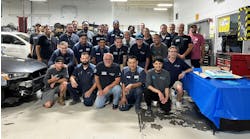"Industry Week" is just concluding as I write this month's column, and to be honest — it is an assignment that I should have completed before I boarded the plane to Las Vegas. Thankfully, I have an understanding managing editor and, as it turns out, the delay provided the spark of an idea that is this month's featured topic.
For those of you who aren't familiar with Industry Week, let me explain that first. Every year, Las Vegas hosts two stellar automotive events: SEMA and AAPEX. The latter is where I find myself spending the majority of my time and, let me assure you, it is all work with very little time to experience the various temptations "Sin City" may be known for. It is a time for our team to meet our various partners face-to-face and thank them for their support, while also allowing us an opportunity to meet new potential partners that will allow us to continue to bring you the best technical and management content possible.
Google diagnostics?
While exploring the trade show, I met a number of vendors offering tool and data solutions to the industry. The overall theme reminded me of a term I first heard from a few good industry friends, Scot Manna and Matt Fanslow — "statistical diagnostics."
Now, in that first conversation, the two were referring to the growing practice of solving customer problems using Google and YouTube as the primary sources of technical information. The technique is simple enough. Just "Google" the customer complaint, see what the top-rated answers are and make the same repairs the posters did. If the problem isn't solved by the first attempt, move on to the next most popular repair result and try that one. Continue the process until you either fix the problem or the customer decides not to come back anymore.
I think the majority of you will be reacting right now in one of two ways. You'll either be laughing hysterically at the thought of approaching a repair in this way or you'll be shaking your head in disbelief that any professional would rely on this approach to solve their customers' problems. And I would agree with either response. Relying on random sources of information and their SEO scores to resolve a customer issue is no better than throwing darts at a diagnostic dart board.
But is that really what is meant by "statistical diagnostics?"
Consider that every time you log on to your service information source of choice, or enter in a customer complaint and repair information to your shop management system, that data is being "farmed." The biggest example I can provide is the data base collected by Mitchell 1 and showcased in their ProDemand service information system. With more than 45 MILLION records incorporated into these results, there is a sufficient amount of information that permits ProDemand to display a lot of potentially useful information to their subscribers.
Take my wife's car, for example. It's a 2014 Toyota Scion and you can see from the initial "1Search" page, the database for her car alone contains over 12,000 records. Of the 12,000 entries, the system is able to highlight common repairs, DTCs and symptoms reported. What do you see from the information shown in Figure 1?
I see a vehicle model that seems to be a pretty dependable platform. The majority of the repairs listed are routine service items with brake pads and rotors making up two of the top three slots. Less than 1 percent of the reported symptoms was related to a "no start" condition. Now compare that to my other vehicle, a 2005 Ford F350, shown in Figure 2.
Yes, I know — I own a Ford "Sick-O" (6.0-liter diesel) that has a known history of issues. But if you weren't already aware of that, what conclusions could you draw based on the 375,000 records collected here? Fuel injectors made the top 5 of most commonly replaced components and the common symptoms results has some serious issues listed; no start, runs rough, lacks power, just as examples.
The information can be drilled down even further. Let's explore a P0304 — Cylinder 4 Misfire DTC on the Scion. In Figure 3, you can see that two common repair items were spark plugs and ignition coils. OK, for a P0304 that could make some sense, right? Since spark plugs were the top item on the list, let's put a set in and see what happens.
Not so fast
Everyone recall the phrase "pattern failures?" It wasn't all that long ago that we, as a technician community united by the introduction of the Internet, were able to share diagnostic problems that led us to identify issues that were common to certain makes and models. Identifying these common issues led to the term "silver bullet fix" in other words, if you experienced certain symptoms you had a high probability of fixing that pattern failure with a known repair. And many of us would go after that common element first before committing any troubleshooting time to it.
Relying on accumulated databases is really no different. In fact, it's more highly organized and, I suspect, more statistically accurate. Hence the term "statistical diagnostics." Most of the top instructors I know include a version of this in their classes, knowingly or unknowingly, when they encourage techs to include resources like iATN and Identifix in their preliminary research. These, too, are widely recognized databases of "known repairs" based on accumulated data.
But it is what follows that recommendation that often falls on deaf ears. That is the admonition to take what is learned in the research and TEST TO CONFIRM that the recommended fix is indeed the fix your customer needs. I had a chance to speak with Mitchell 1's Ben Johnson while at AAPEX and he is adamant that, while Mitchell 1 has one of (if not the) largest database in the industry, they would never lead a tech to replacing a part without first confirming that that part would indeed correct the concern. And ProDemand helps you do just that by including a section called "Guided Component Testing" (Figure 4). This section brings you quickly to real world testing methods you can use to isolate (in our case) whether it is the spark plug or the ignition coil causing the misfire on our Scion, a small sample of which is shown in Figure 5.
Database or SEO
Mitchell 1, iATN, Identifix, ALLDATA and others have one thing in common. Their databases are based on real world input from their users — professional techs and shop owners. The larger the database, the more statistically accurate the results are and that makes them valuable diagnostic resources.
But what about Google (Figure 6) and YouTube? Many techs, including myself, have gone there looking for direction on tough diagnostic challenges. But you may stop (as I have) after you consider what I'm going to share now.
Unlike the professional sources mentioned, the results you see after keying in a question on your browser of choice is not based on statistical records. It's based on SEO, or the Search Engine Optimization, of the content that pops up. I'm no expert in the field, but I do know that it is based a lot more on popularity than it is the statistical accuracy of the material. And the sources of the information are often less than professional — many entirely inaccurate or advocating methods or repairs that are totally out of line with industry practices and OEM processes. To rework an old phrase, "Let the viewer beware!"
Statistical databases are just another tool in a good diagnostician's repertoire and not a replacement for testing and verification. Following Internet search results blindly only wastes your time and your customers' money, while adding to the infamous reputation we need to work so desperately to correct. Confine your statistical searches to "known good" sources of information and use Google or YouTube to entertain yourself between jobs — not to help you complete them.


